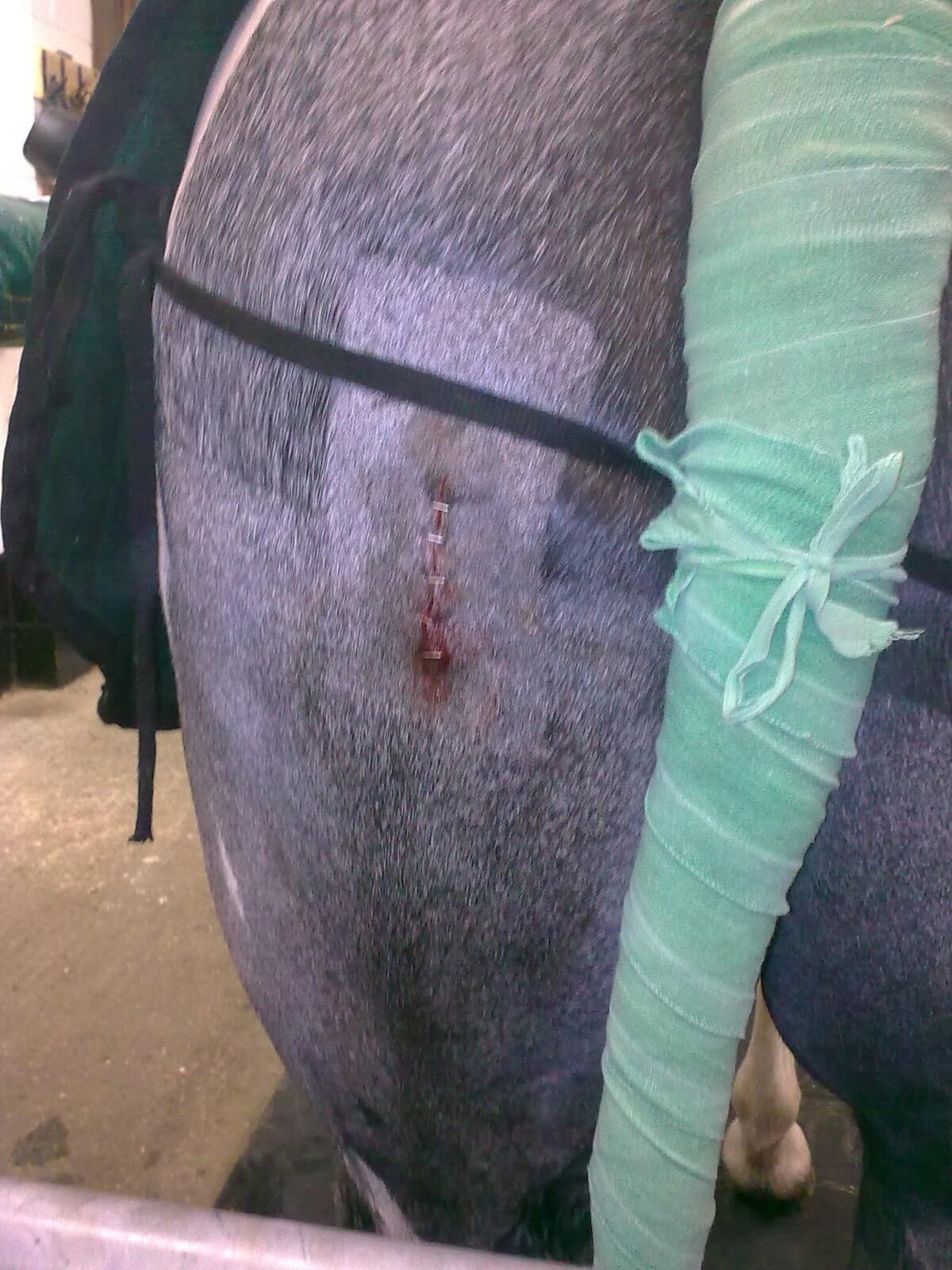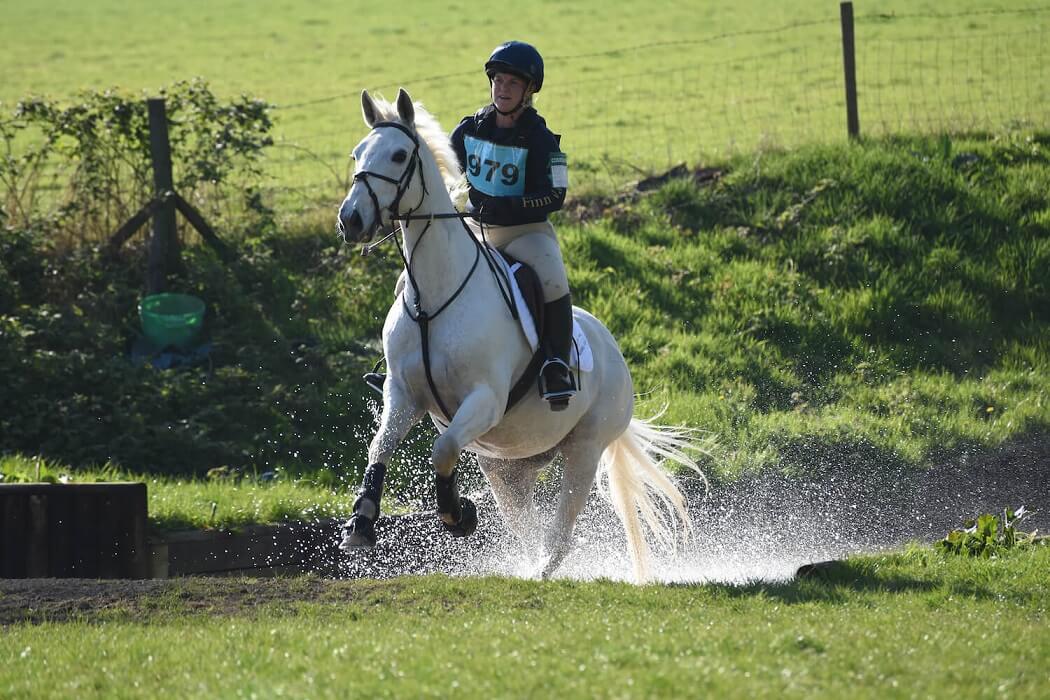Historically known as Monday Morning disease, ER is most often seen in horses following exertion, such as racehorses, hunters and endurance horses, but can occur in any horse.
We will explore the signs, the causes, how we diagnose and treat the disease and what we can do to prevent episodes occurring. We will also look at other, less common, muscle disorders.
What is Exertional Rhabdomyolysis?
ER means the breakdown of muscle following exercise. Historically it was thought that it was caused by the build-up of lactic acid in the muscles, but this is not the case anymore. Instead, it is thought that there is a problem with the way that muscle cells work, which results in damage to these cells. This causes the muscles to spasm and become solid, and the cells to break down – releasing myoglobin into the bloodstream. Not only is this terribly painful for the horse, but myoglobin is toxic.
It is important to understand that ER is a clinical sign rather than a disease in itself, and will have an underlying cause or reason.
Some horses are more prone to ER than others- thoroughbred mares, in particular, are at high risk, but there are external causes which can cause ER. These will be explored later.
Symptoms of a tied-Up horse
Short striding and general discomfort when moving- quite often have an awkward gait.
Reluctance or refusal to move
Severe contraction or spasm of the large muscles in the horse’s hindquarters or back- the horse’s muscles will feel hard and are often painful to touch
Sweating and anxiety, trembling
Increased respiration, heart rate and temperature
Urine production will be decreased. Urine may be stained red or brown. This is a bad sign
These signs can be quite non-specific and can commonly be mistaken for other diseases, such as colic or laminitis. Either way, prompt diagnosis is vital for a horse showing any of these signs, and therefore, you should contact your vet immediately.
Diagnosis
Your vet will suspect that the horse is suffering from ER from clinical signs and history, but diagnosis must be confirmed by blood testing. This will check the levels of enzymes Creatinine Kinase (CK) and Aspartate aminotransferase (AST) in the blood, which are the markers of muscle destruction. Further diagnostic information can be made by sampling urine, performing a muscle biopsy, and by genetic testing. This extra information will help establish the reason why a horse has tied- up and is particularly useful if the horse has recurrent episodes.
Treatment
 Muscle biopsy.
Muscle biopsy.
Treatment is targeted to prevent further damage, help control pain, and potentially address underlying causes of the syndrome.
- Horses should be rested- movement will cause further muscle damage, and so the horse should initially be kept in a stable
- Any dehydration should be addressed; horses may be stomach tubed to give a bolus of water and electrolytes. In severe cases, the horse may need IV fluids (drip), to help flush high quantities myoglobin through the kidneys to minimise damage.
- Pain relief will be administered.
- A tranquilliser which helps with muscle relaxation may be given.
- It is important to keep the horse warm- as this prevents further damage to the muscles.
- Horses should be encouraged to drink.
- Horses should be fed a low starch/sugar diet.
- The large muscle groups (particularly around the rump) can be massaged to help soften and aid pain relief.
Treatment will be guided by your horse’s response to therapy. This is best monitored by clinical examination and sequential blood testing.
A recovery and rehabilitation program will be devised by your vet, but will likely include a slow introduction back into work, and preventative measures (see below) to prevent further tying up.
Muscles usually recover within 3-4 weeks, although after a serious episode, you may notice that the muscle may appear shrunken.
Prevention
Careful and sensible management can greatly reduce the risk of an episode of ER recurring.
Work
- Horses with ER need to be worked in for longer. 20 mins of gentle walking as a warm-up has been shown to greatly reduce the probability of an ER episode occurring- as well as preventing other injuries.
- Using an exercise sheet on the quarters of the horse while you are warming up is also an effective precaution.
- Care should also be taken to ensure that the horse is adequately warmed down after work too, using stretching and gentle walking. This period should also last around 20 minutes, or longer if your horse’s respiratory rate is still elevated.
- If you know you have worked your horse particularly hard (such as for a competition or a day’s hunting) it is just as important to gently walk your horse the day after too. Allowing him to stretch and relax.
- Ideally, horses that have worked hard should not be left in the stable the following day. If they have to stay in, it is vital that they are walked out, either in hand or ridden.
Feeding and stable management
- Only feed the necessary amount of feed. Overfeeding puts your horse at a markedly increased risked risk of ER.
- Horses that suffer from ER should be fed a low starch diet, avoiding quick release carbohydrates that are found in cereals. There are plenty of diets available commercially, but the things to look for are that they are low in sugar, cereal free and high in fibre. Most feed companies have nutritionists working with them who can advise on suitable diets for your horse and his workload (RE-LEVE®- by SARACEN or ERS Cubes by Dodson and Horrell)
- Ensure that your horse is receiving a balanced and complete diet. Deficiencies in vitamins and minerals can cause ER. Feeding a balancer (at the correct rate) will prevent deficiencies.
- Most horses in moderate/heavy work will require additional electrolyte supplementation. There is very little point feeding electrolytes as a one-off, instead, feed a maintenance dose, and feed additional amounts after the horse has sweated heavily. Electrolytes can be added to feed or water as a powder or syringed as a paste.
- Ensure your horse has a clean fresh supply of water at all times. If giving electrolytes in water make sure you also offer normal water too! Encourage your horse to drink when they are away from home too; adding chopped up bits of apple or peppermint flavouring to the water may help. You can also add extra water to your feeds- creating a mash, to increase water intake.
- Avoid chilling! Use rugs, and only clip for work load- avoid removing hair from rump unless entirely necessary.
Causes
There are many causes of ER, we will explore the most common. If you suspect your horse is showing signs of ER, prompt examination and treatment are vital.
Carbohydrate overload
Overfeeding of high carbohydrate foods with high sugar content, such as cereal mixes, can result in ER, particularly when combined with insufficient exercise. Similarly, accident overload, such as breaking into the food store, can result in ER.
Vitamin deficiency
Deficiency of certain vitamins which act to protect the muscles from oxidative damage from free radicals can result in ER. Free-radicals are created from the breakdown of normal dietary components during exercise, and exposure to them can cause muscle damage. Anti-oxidants; such as Vitamin C, Vitamin E, and copper, are protective against this damage. Additional antioxidants, selenium, may be added to the diet if this is the suspected cause but should be done so under veterinary advice.
Electrolyte deficiency
Electrolyte and fluid deficiency can contribute to ER. When a horse works hard and sweats, particularly for prolonged periods they will lose a large amount of salts. These need to be replaced. Imbalances in electrolytes have been implicated in causing ER.
Recurrent Exertional Rhabdomyolysis (RER)
Recurrent exertional rhabdomyolysis (RER) is an intermittent form of tying up in horses that past research points to an abnormality in intracellular calcium regulation as the possible cause. At present, there is no specific diagnostic test for RER. The diagnosis is best made based on several observations: a history of repeated episodes of tying-up in fit horses that are on a well-balanced diet and reasonable training regime; demonstrated elevations in serum CK activity with exercise; and muscle biopsy abnormalities without evidence of abnormal polysaccharide. Horses with RER often develop tying-up when they are overly excited.
It is thought that RER is an inherited trait, but unless the horse is exposed to risk factors, then they might not show clinical signs.
RER is most frequently seen in thoroughbreds, but other breeds can be affected too.
Management of RER should focus on managing the stressful triggers, these can include:
- Positioning the horse in a quiet area of the yard
- Time of training (first rather than last)
- Turn-out (if available a big advantage, the more time to blow off steam and move about the better)
- Avoid training regimes like holding back at a gallop or intervals that excite the horse
- Attention to and treatment of lameness
- Avoid box rest or lay-up if possible, provide calm exercise if the horse has been rested the day before
Polysaccharide Storage Myopathy (PSSM)
First identified in 1992 in quarter horses and appaloosa’s PSSM is characterised by the build-up of glycogen (and related polysaccharides) within the muscle fibres which are resistant to breakdown by the enzyme diastase.
Since its discovery, the disease has been identified in several breeds of horse, including European breeds. It is now understood that there are 2 different types of PSSM: Type 1 caused by a mutation in the gene which codes for glycogen, and Type 2 which does not have this genetic mutation, so cause is currently unknown. Type 1 can be tested for.
Signs of PSSM:
Exertional rhabdomyolysis is the most commonly and perhaps easily recognised clinical syndrome. Exertional rhabdomyolysis was reported in over 90% of affected cases in one study.
Other sub-clinical signs can include:
- Poor performance
- Muscle fasciculations (shivering)
- Muscle atrophy (wastage)
- Gait abnormalities
- Generalised or pelvic limb stiffness
- Undiagnosed lameness or back pain
- Interestingly, PSSM-affected horses are often described as having a calm demeanour
